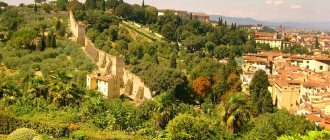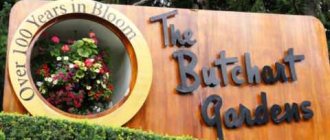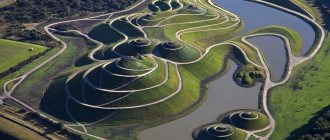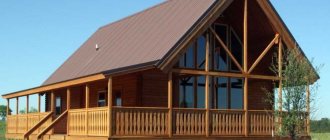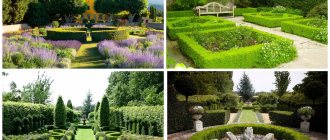Views: 25,354
Bird's eye view of Versailles Park. 19th century
Versailles is a palace and park ensemble in France, the former residence of French kings in the city of Versailles, now a suburb of Paris; center of tourism of world importance.
Versailles was built under the leadership of Louis XIV from 1661 and became a kind of monument to the era of the “Sun King”, an artistic and architectural expression of the idea of absolutism. The leading architects are Louis Levo and Jules Hardouin-Mansart, the creator of the park is Andre Le Nôtre. The Versailles ensemble, the largest in Europe, is distinguished by its unique integrity of design and harmony of architectural forms and transformed landscape. Since the end of the 17th century, Versailles has served as a model for the ceremonial country residences of European monarchs and aristocracy, but there are no direct imitations of it.
From 1682 to 1789, before the French Revolution, Versailles was the official royal residence. In 1801 it received the status of a museum and is open to the public; since 1830, the entire architectural complex of Versailles has become a museum; In 1837, the Museum of French History opened in the royal palace. In 1979, the Palace of Versailles and its park were included in the UNESCO World Heritage List.
Versailles Gardens – a landscape illustration of royalty
The gardens of Versailles arose and existed as an integral part of the country residence of the kings of France. Initially, Louis XIII set up a small hunting lodge here. The main construction at Versailles began during the era of his son Louis XIV. The luxurious palace and park complex, the construction of which the king carefully supervised, became the true embodiment of the absolutist monarchy and the power of the Sun King, as Louis was nicknamed. Simply fantastic sums were spent by the treasury to please the picky taste of the king; construction dragged on for half a century.
About six million tourists visit Versailles every year. It is impossible not to admire the beautiful examples of regular architecture, gardens and numerous fountains, the hydraulics of which have been functioning perfectly since the time of the Great French Revolution.
True, the Park of Versailles has limited water resources, so all the fountains are turned on at full power only on the days of impressive shows, which usually take place on weekends in the summer months.
The creation of the Versailles gardens began under the leadership of Claude Molay and Hilary Mason in the 30s of the seventeenth century, in the sixties, when the Sun King decided to establish his residence in Versailles, the artist Lebrun, the architect L. Levo and those who can be called creative began to work here the father of the garden is Andre Le Nôtre.
The main features of the landscape design of Versailles were laid down under Louis XIV, although several large-scale redevelopments were carried out over the years, plants were replanted, but the general architectural and landscape concept was basically preserved and recreated. The reasons for the changes were both objective reasons (replacing old trees, eliminating the destructive consequences of hurricanes, etc.) and subjective ones - changes in the tastes of the reigning persons, who certainly wanted to reflect their aesthetic vision in the Versailles Gardens.
Characteristic elements of the Versailles gardens include ponds, bosquets, grottoes and fountains, which are often located and named so as to form certain symbolic chains and associations. In the goddess Latona, who was the mother of the sun god Apollo, it is easy to guess the mother of Louis XIV, Anna of Austria, known to everyone from the novels of Dumas. It is from the fountain dedicated to Latona that we will begin our short walk through the Versailles Gardens. By the way, when going on a real walk here, develop a plan in advance, so even in a whole day you won’t be able to get around the gigantic territory of the complex.
Trianon Palaces
Louis XIV took a break from the strict etiquette of court life in the one-story Grand Trianon palace (“secluded place”), specially built for this purpose. The façade of the palace is lined with pink and green marble. It had more than 30 rooms, a private courtyard and a park with ponds.
Grand Trianon
The Petit Trianon is a gift from the next Louis to his favorite Madame du Barry. Later, Marie Antoinette, the wife of Louis XVI, fell in love with him.
Petit Trianon
Nearby, for the queen’s entertainment, a farm (mini-village) with houses, a mill and a lake was built. Stalls for goats and cows, a dovecote and roosts for chickens were built here. The queen's ladies-in-waiting dressed up and portrayed peasant women.
Opening hours of the palaces and farm: from 12 to 17:30–18:30 hours.
Latona Pool
It is located down from the Water Parterre and slightly offset to the left of the east-west axis. The pool is decorated with statues erected here in 1688-1670, inspired by an ancient myth, according to which Latona and the little Apollo and Diana could not drink water from the pond, since the peasants threw lumps of dirt and silt into the water. Jupiter, hearing Latona's pleas for help, turned the evil peasants into lizards and frogs.
The sculpture of the goddess was made by the Marcy brothers, her children stand nearby, and the heads and backs of frogs protrude from the water of the pool; other frog figures are not in the water, but along the borders of the lawn.
Church of the Virgin Mary
Eglise Notre-Dame de Versailles was built at the end of the 17th century. by order of Louis XIV. The author of the project is one of the architects of the Palace of Versailles, Jules Hardouin-Mansart. In the first parish church of Versailles, three Louis – XIV, XV and XVI – participated in religious rites. It also recorded baptisms, marriages and deaths of members of the royal family.
Church of the Virgin Mary
The building was built in the style of French classicism. Its façade is decorated with allegorical figures of Religion and Charity. The height of the church was limited to two floors by order of Louis XIV, so as not to interfere with the city views from the Palace of Versailles.
Apollo Pool
Moving further along the east-west axis, we come to the Apollo Pool, built in 1668-1671, which replaced the Swan Pool on this site. The new pool was expanded and acquired a beautiful sculptural group depicting the brilliant Apollo in a chariot, making a voyage across the sky. The figures are covered with gold to emphasize the sunshine of Apollo (with whom the court poets liked to compare the king). This fountain connects the Small Park and the Grand Canal.
reference Information
Address: Place d'Armes. Typically, travelers come to Parc et château de Versailles from Paris for the whole day. The most convenient way to get there is by the inner-city Paris train RER line C. After half an hour, you need to get off at the Versailles-Rive Gauche station, after which you walk 10 minutes. An alternative option is by bus number 171 from the Paris metro station Pont de Sevres.
To visit the palace and park ensemble of Versailles, you can purchase the following ticket options:
- Full one-day – 20/27 (with included fountains) EUR;
- Full two-day – 25/30 EUR;
- Chateau (main palace only) – 18 EUR;
- Trianon Palaces + farm –12 EUR;
- Park – free/9 (with fountains included) EUR;
- Night fountain show –24 EUR;
- Ball – 17 EUR;
- Night fountain show + ball – 39 EUR.
Fottans are on on weekends from 11 to 12 and from 15:30 to 17:30. To guarantee your visit, it is better to purchase tickets in advance online. This, for example, can be done on the website. To avoid crowds, experts do not recommend coming here on Sunday and Tuesday – a day off for Parisian museums.
The nightly fountain show takes place every Saturday in May–September after the ball in the Hall of Mirrors. It ends at 11 p.m. with fireworks over the Grand Canal. To make your visit as educational as possible, it is recommended to first watch a detailed video about Versailles.
The main entrance to the Chateau leads into its courtyard, from where you can enter the palace or park. A typical tour of the Chateau includes the chapel, the living rooms (salons), the Throne and Mirror Halls, the chambers of the king and queen, and the War salon with paintings on the themes of French military victories.
To move around the huge park, you can rent a Segway or a bicycle, and to walk along the Grand Canal, you can rent a boat. A tourist train runs between the Chateau and the Trianon Palaces, the ticket costs 7.5 EUR.
Grand Canal
The Grand Canal is 1,500 meters long with a considerable width of 62 m and stretches along the east-west axis, reaching the walls of the Grand Park. Its construction took place in 1668-1671; the canal served as a place for boat trips for the nobility, which sometimes took on quite grandiose forms. In 1674, at the behest of the monarch, Little Venice arose on the canal, sheltering yachts with caravels sent from Holland and Venetian gondolas donated by the Doge. The Grand Canal also has a practical purpose - all the water drained from the fountains flows into it, since it is located at the lowest point.
Hunting castle
The history of the Palace of Versailles begins in 1623 with a very modest hunting castle, similar to a feudal one, built at the request of Louis XIII from brick, stone and roofing slate on territory purchased from Jean de Soisy, whose family owned the lands since the 14th century. The hunting castle was located in the place where the marble courtyard is now located. Its dimensions were 24 by 6 meters. In 1632, the territory was expanded through the purchase of the Versailles estate from the Archbishop of Paris from the Gondi family, and a two-year reconstruction was undertaken.
Water parterre
Somewhat above the Latona pool there is a palace terrace, which is called the Water Parterre. It is a key location as it lies between the Palace of Versailles and the gardens below.
This is an excellent vantage point; the panorama that opens from here is mesmerizing and gives a clear idea of the impeccable symmetry of the gardens, and when you look at the palace, you are immediately imbued with the majesty of its architecture. In 1664, by royal order, more than 20 statues were made to decorate the Water Parterre.
The statues reflected the plots of ancient myths related to abduction.
The spruce pond is paired with the Swiss pool, they are located along the north-south axis, in the north direction from the palace. The Spruce Pond was built in 1676, and the Swiss Pool (it was called that because the Swiss Guards took part in the work on its creation) - in 1678. Subsequently, the Spruce Pond was converted into the Neptune Pool, but the Swiss Pond still occupies 15 hectares of area and is the largest hydrographic object in the Versailles Gardens after the Grand Canal.
In the gardens of Versailles there are still a huge number of beautiful places, ponds, galleries, colonnades, bosquets, you can’t even list them all. And if you are nearby, we strongly advise you to set aside a day to explore this amazing palace and garden complex.
Just keep in mind that even today the problems with the lack of water for the fountains in the Versailles gardens have not been solved, which is why they are turned on for only a few hours on certain days (usually on weekends and holidays), so check the schedule in advance to catch the Versailles fountains working , because they are one of the most memorable features of the park. Enjoy your walk through the Versailles Gardens!
Attractions
The Palace of Versailles is one of those tourist places that is difficult to get around in one day. The area of the gardens alone occupies about nine hundred hectares of land. On the territory of the museum complex there are three palaces: the main, Grand and Small Trianon. Also especially popular among tourists are the royal stables and the village of Marie Antoinette.
Royal Chapel, © Michael the Wanderer
Petit Trianon Palace
The name of its last owner, Marie Antoinette, is most associated with the Petit Trianon Palace. The young queen spent almost all her time away from the main palace and the courtiers who disliked her. Entrance to his park was allowed only at the invitation of the queen. Built in 1768 under the previous ruler, it was almost completely remodeled. Next to it appeared a theater building and a small utopian village, where she was immersed in a non-existent rural life.
© Mikhail Wanderer
Village of Marie Antoinette
Queen Marie Antoinette was a creative and enthusiastic person. She was burdened by palace life and surroundings, so after the Petit Trianon Palace was transferred to her, she ordered a staged village of 12 houses to be built for her. To recreate peasant life, cattle and poultry were brought here.
© Mikhail Wanderer
Now many tourists really like to visit this place. It amazes with its beauty and peaceful atmosphere. Almost all the cute little houses are located around the pond. The village itself is a 10-minute walk in a northeast direction from Trianon.
© Mikhail Wanderer
Grand Trianon Palace
The Grand Trianon or Marble Palace was built specifically for the king and his entourage. It was considered a privilege to travel here. After the revolution, Napoleon and General Charles de Gaulle chose it for their residences. It is notable for its exterior facades decorated with pink marble and flowering gardens around.
© Mikhail Wanderer
Components of the palace and park area
It is simply impossible to describe the sights of the Palace of Versailles, since everything in the ensemble is so harmonious and elegant that every detail is a real work of art. During your excursions you should definitely visit the following places:
- Grand Trianon (used for outdoor recreation);
- Petit Trianon (was the home of the favorite of Louis XV);
- Opera Hall;
- Marie Antoinette's farm;
- The King's Chambers;
- Mirror gallery.
At the main entrance to the palace complex there are gates made of gold, decorated with a coat of arms and a crown. The square in front of the palace is decorated with sculptures, which are also found inside the main room and throughout the park. You can even find a statue of Caesar, whose cult was valued by French masters.
Separately, it is worth mentioning the Park of Versailles, as it is an exceptional place, enchanting with its diversity, beauty and integrity. Here you can find amazingly decorated fountains with musical arrangements, botanical gardens, greenhouses, and swimming pools. Flowers are collected in unusual flower beds, and shrubs are given certain shapes every year.
Cathedral of St. Louis
Cathédrale Saint-Louis de Versailles was built in the classicist style in the mid-18th century. designed by the architect Jacques Harduzn-Mansart (grandson of Jules - see above). At the end of the 18th century. Church of St. Louis received the status of the Cathedral of the Versailles diocese.
The main facade of the cathedral is somewhat reminiscent of the Church of the Virgin Mary, but looks more elegant. The upper part is decorated with a triangular pediment with the royal coat of arms surmounted by a golden cross. Under the pediment there is a large window with a clock dial. On the lower level of the facade there are three doors separated by Doric columns.
Cathedral of St. Louis
Inside the cathedral, the Great Organ, installed here in the second half of the 18th century, attracts attention. It weighs 53 tons and has 3131 pipes in 46 registers and three keyboards.
Address: Place Saint-Louis, 4. Admission is free.
Versailles after the Bourbons
Versailles witnessed the apogee of Bourbon royal power and its fall. It was in Versailles that the meeting of the Estates General took place in 1789, which gave rise to the French Revolution. On October 5, 1789, the Parisians advanced on Versailles, captured it and brought the royal family to Paris. The palace was abandoned.
In 1791, paintings, mirrors and emblems of the king were torn from the walls and ceilings. The works of art were transported to the Louvre, which became the central museum in 1792.
In 1793-1796. The palace furniture was sold out. The most beautiful interior items went to England to Buckingham Palace and Windsor Castle.
The revolutionary government at one time intended to destroy the palace. Poor people tore out flowers in the garden to plant potatoes and onions in their place. The Petit Trianon turned into a tavern, and revolutionaries met in the Opera and the royal chapel.
For some time, the castle served as a warehouse for property confiscated from aristocrats. In 1795 it became a museum.
Under Napoleon, the palace was transferred to imperial ownership. Napoleon arrives and decides to settle in the Grand Trianon. And improvement work began again: in 1806, a series of tapestries were ordered for the palace and statues were removed from museums. Numerous plans to improve and remodel the palace under Napoleon cannot be implemented.
After the Restoration, Louis XVIII undertook a series of works with the aim of turning the palace into his summer residence. However, he understands that living in Versailles will have a bad effect on his image, and abandons the idea.
In 1833, King Louis Philippe entrusts his minister Camille Baschasson with the task of transforming the palace into a museum of French history, dedicated to the military victories of the old regime, the French Revolution, the Empire and the Restoration. The restoration of the palace was undertaken by the architect Pierre Fontaine. For his personal use, Louis Philippe orders the Grand Trianon to be put in order. In 1837, the wedding of his daughter, Princess Mary, is celebrated there.
For the museum of the military glory of France, in the southern wing of the palace, instead of the prince’s chambers, the Battles gallery is being built, striking in its size (120 m long and 13 m wide). It was decorated with 32 huge paintings glorifying the victories of France from the Battle of Tolbiac in 496 to the Battle of Wagram in 1809. The most popular paintings were those of Horace Vernet. The museum became very popular.
Gallery of battles
During the Second Empire, a hall was added to the museum to commemorate the victories in the Crimean and Italian campaigns. Napoleon III maintained the palace in good condition. And Empress Eugenie contributed to the partial return of the original furniture.
In 1870, France was defeated by Prussian troops, and Versailles became the headquarters of the Prussian headquarters during the siege of Paris. The Hall of Mirrors houses a hospital; The Crown Prince of Prussia awards his officers at the statue of Louis XIV. The birth of the German Empire is proclaimed at Versailles.
In 1871, the administration of France passes to the Paris Commune, its administrative bodies are located in Versailles. The National Assembly meets in the former royal opera house; 23 thousand prisoners are taken to the greenhouse, many of whom are executed in the park. In 1879, the parliament moved to Paris, but until 2005, both chambers maintained their premises in Versailles.
An important role in the preservation of Versailles was played by the historian Pierre de Nolac, who was appointed custodian of the palace in 1887. By that time, the palace and gardens had been neglected for 20 years, so much so that even the names of the ponds were forgotten. Nolyak plans to equip a real historical museum, organized according to all the rules of science. He strives to return the palace to its pre-revolutionary appearance. High society rushes to the opening of the new Versailles. Nolyak invites foreign guests and arranges receptions for potential patrons of the arts.
On June 28, 1919, an agreement was signed in Versailles to end the First World War, called the Treaty of Versailles. The location was not chosen by chance: France was waiting for revenge after a humiliating defeat in the Franco-Prussian War of 1870.
The palace and gardens suffer from a lack of finances. In 1924 and 1927, John Davison Rockefeller donated to the restoration of palace artwork and fountains. The nobility of the American millionaire prompted the French government to allocate budget money for restoration.
Mirror gallery
During the Second World War, the palace was again owned by the Germans.
In the post-war period, the curator of Versailles, Morichaud-Beaupré, was again concerned with raising funds for the restoration of the palace and park. In 1952, he addressed the French on the radio: “To say that Versailles is in ruins is to say that Western culture is losing one of its pearls. This is a masterpiece, the loss of which will be a loss not only for French art, but also for the image of France that lives in each of us and which cannot be replaced by anything else.” The call was heard, many French took part in raising funds for the restoration of Versailles.
Versailles becomes a state palace at the disposal of the president. It has hosted foreign heads of state, such as John Kennedy in 1961, Elizabeth II in 1957 and 1972, the Shah of Iran in 1974, Mikhail Gorbachev in 1985 and Boris Yeltsin in 1992. In 1959 General de Gaulle is undertaking work to reconstruct the Grand Trianon for the accommodation of foreign guests; one wing is allocated to the French president. In 1999, these rooms were again renovated to their original condition.
The history of Versailles in a mini-film:
1. from Louis to the Revolution -
2. after the Revolution -
3. Versailles Gardens -
